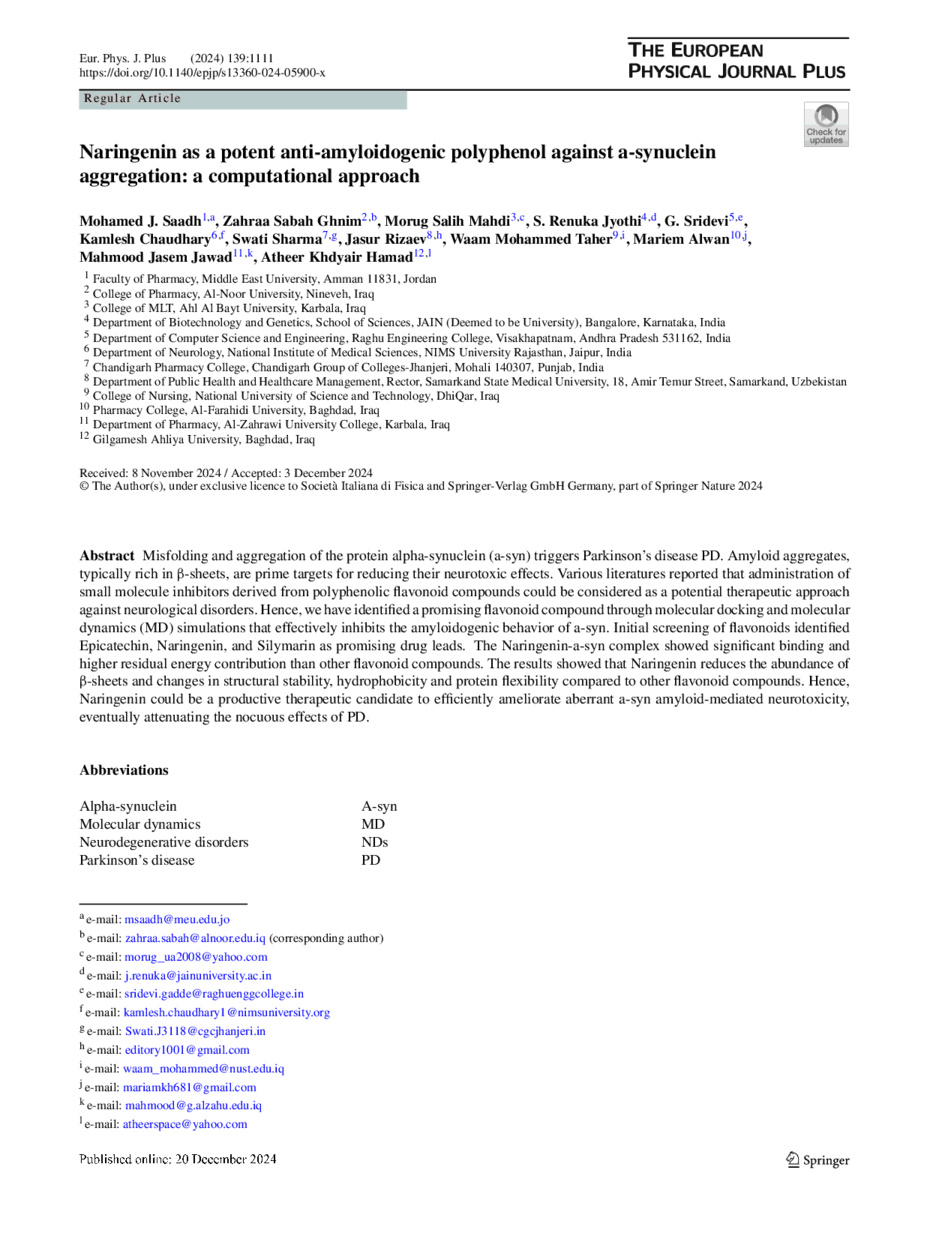https://doi.org/10.1140/epjp/s13360-024-05900-x
Regular Article
Naringenin as a potent anti-amyloidogenic polyphenol against a-synuclein aggregation: a computational approach
1
Faculty of Pharmacy, Middle East University, 11831, Amman, Jordan
2
College of Pharmacy, Al-Noor University, Nineveh, Iraq
3
College of MLT, Ahl Al Bayt University, Karbala, Iraq
4
Department of Biotechnology and Genetics, School of Sciences, JAIN (Deemed to be University), Bangalore, Karnataka, India
5
Department of Computer Science and Engineering, Raghu Engineering College, 531162, Visakhapatnam, Andhra Pradesh, India
6
Department of Neurology, National Institute of Medical Sciences, NIMS University Rajasthan, Jaipur, India
7
Chandigarh Pharmacy College, Chandigarh Group of Colleges-Jhanjeri, 140307, Mohali, Punjab, India
8
Department of Public Health and Healthcare Management, Rector, Samarkand State Medical University, 18, Amir Temur Street, Samarkand, Uzbekistan
9
College of Nursing, National University of Science and Technology, DhiQar, Iraq
10
Pharmacy College, Al-Farahidi University, Baghdad, Iraq
11
Department of Pharmacy, Al-Zahrawi University College, Karbala, Iraq
12
Gilgamesh Ahliya University, Baghdad, Iraq
Received:
8
November
2024
Accepted:
3
December
2024
Published online:
20
December
2024
Misfolding and aggregation of the protein alpha-synuclein (a-syn) triggers Parkinson's disease PD. Amyloid aggregates, typically rich in β-sheets, are prime targets for reducing their neurotoxic effects. Various literatures reported that administration of small molecule inhibitors derived from polyphenolic flavonoid compounds could be considered as a potential therapeutic approach against neurological disorders. Hence, we have identified a promising flavonoid compound through molecular docking and molecular dynamics (MD) simulations that effectively inhibits the amyloidogenic behavior of a-syn. Initial screening of flavonoids identified Epicatechin, Naringenin, and Silymarin as promising drug leads. The Naringenin-a-syn complex showed significant binding and higher residual energy contribution than other flavonoid compounds. The results showed that Naringenin reduces the abundance of β-sheets and changes in structural stability, hydrophobicity and protein flexibility compared to other flavonoid compounds. Hence, Naringenin could be a productive therapeutic candidate to efficiently ameliorate aberrant a-syn amyloid-mediated neurotoxicity, eventually attenuating the nocuous effects of PD.
Copyright comment Springer Nature or its licensor (e.g. a society or other partner) holds exclusive rights to this article under a publishing agreement with the author(s) or other rightsholder(s); author self-archiving of the accepted manuscript version of this article is solely governed by the terms of such publishing agreement and applicable law.
© The Author(s), under exclusive licence to Società Italiana di Fisica and Springer-Verlag GmbH Germany, part of Springer Nature 2024
Springer Nature or its licensor (e.g. a society or other partner) holds exclusive rights to this article under a publishing agreement with the author(s) or other rightsholder(s); author self-archiving of the accepted manuscript version of this article is solely governed by the terms of such publishing agreement and applicable law.





